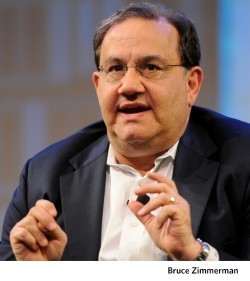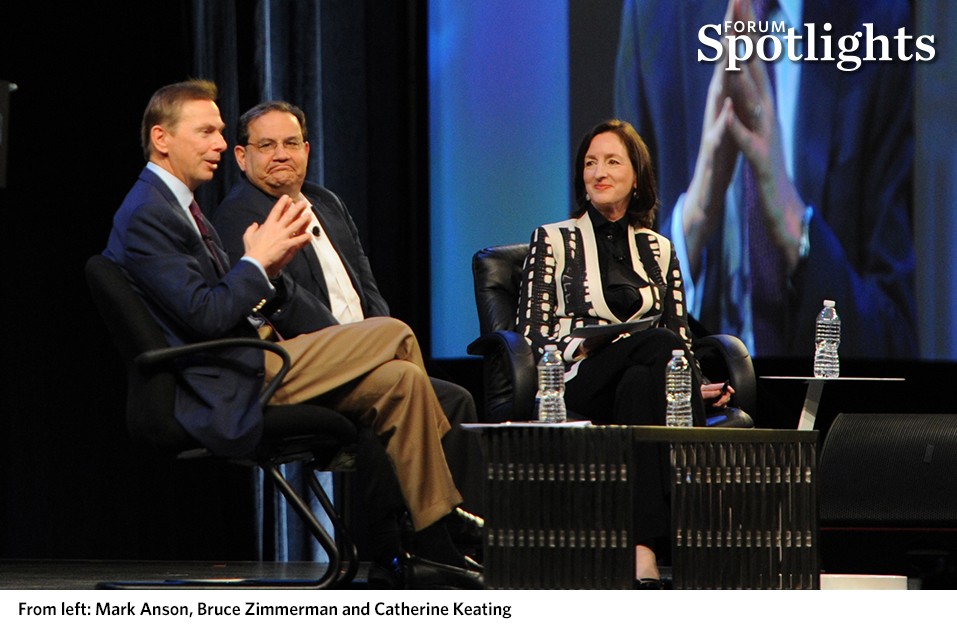Asset allocation is still the foundation on which better risk-adjusted returns are built. But asset allocation has changed, along with all the associated tools for pursuing return and managing risk. Have you kept up?
At Commonfund Forum 2016, Mark J. P. Anson, Commonfund’s CIO, and Bruce Zimmerman, CEO and CIO of the University of Texas Investment Management Company (UTIMCO) and also a Commonfund Trustee, took part in a dialogue moderated by Commonfund CEO Catherine Keating. Excerpts from their discussion follow. UTIMCO invests over $35 billion, and is the second largest endowment pool in the country and the largest among public universities.
Keating: There’s broad agreement that the most fundamental decision any CIO makes concerns strategic asset allocation. After the developments of the past few decades, today there are three common frameworks. The first is the traditional asset allocation framework—a 70/30 or 60/40 stock/bond blend using equity for growth and fixed income for protection. The second is the endowment model. This is an approach that Commonfund pioneered in which alternative assets are added to the traditional model to earn an illiquidity premium. There are also newer models, and one that I would highlight is risk parity, which attempts to balance risks across all asset classes.
So, Bruce and Mark, how do you think about these different frameworks today and how do you decide what strategy you want to pursue in setting your asset allocation? Bruce, I’ll start with you.
Zimmerman: It’s an important question, but the right answer isn’t necessarily the same for everyone. You need to understand what your objectives are and what your capabilities are. In some cases, a 60/40 passive approach is sufficient, and it may be all that an investor can successfully execute. I would argue it would be better to do that well than to unsuccessfully try to execute some of the other models.

— Bruce Zimmerman
Risk parity is very interesting to me because it has gained a lot of followers recently, and it’s appealing in that, arguably, you should be able to generate a little more in the way of return and it should be the smoothest path, that is, the one offering lower volatility risk.
When I think about the endowment model—which is what we use at UTIMCO —I think about illiquidity risk, equities for the long run and active management. Assuming you have the right investment organization or access to the right investment organization, and your investment committee understands risk, that’s the model I would vote for.
 Keating: Mark, your perspective?
Keating: Mark, your perspective?
Anson: I’d like to start with risk parity, come back to the endowment model, and then maybe stretch the endowment model a bit.
Let’s just take a simple two-asset case of stocks and bonds to explain what risk parity is. You’re trying to balance between stocks and bonds so that they’re both contributing an equal amount of risk to the portfolio. We know stocks are more risky, than bonds. So, in order to achieve a balance where each asset class is contributing the same amount of risk to the portfolio, you have to overweight bonds significantly and underweight equities so that the overall component of risk contributed by bonds is equivalent to the amount of risk that equities are contributing. Then, to generate sufficient return, given that you now have a larger overweight to bonds compared to equities, you have to lever up the portfolio.
So, the two things you have to worry about in risk parity are: how do you balance the different asset classes so that they’re all contributing the same amount of risk to the portfolio—meaning that bonds are going to be a much bigger component of your portfolio—and then you have to use leverage to gear up the returns. That’s a great strategy in a market where bonds are rallying. But we all know that we’re looking at a period of time when interest rates are going to go up. So, if you follow through on risk parity right now, you’re going to be overweighting an asset class that has headwinds facing it. Then you’re going to add leverage on top of it. So risk parity was born and worked great during the bond rally that we’ve had for the last 30 years. How it will work with bonds facing a headwind remains to be seen. I’m less sold on risk parity because of that bond risk. Plus, it means that duration is the key risk, not volatility.
The endowment model still applies. Why? Because its key tenet is assuring that you’re accessing every asset class, collecting all the beta risks and then optimizing them so that you have the best diversified portfolio for the level of return you expect to earn. It’s based on modern portfolio theory born with Harry Markowitz and Bill Sharpe, and then expanded across all the asset classes. It’s the model used at Commonfund, UTIMCO, Harvard, Stanford and some others.
What would be the next evolution? One of the things we saw in the great financial recession of 2008 was asset class correlations rising as the markets crashed. What we learned is that there are some long-term macro drivers—four of them—that run through all asset classes. The first is real interest rates. That affects every asset class, from bonds through equities to hedge funds to private equity. The second is inflation. That’s a pretty obvious one. Then there’s growth, or building a portfolio that’s tied to the long-term growth of not only the United States but the global economy. And the last is risk premium capture. When you invest in an asset class, you should have an expectation of capturing some risk premium associated with that asset class. But the key point is that the endowment model still applies. Diversification still works. What we really have to think about is our risk budget for the expected return we need to earn—e.g., CPI plus 5 percent—and the other macro factors that might wash through the portfolio and have a broad impact across the asset classes.
Keating: Let’s switch from asset allocation to time allocation. Bruce, how do you make sure your committee or your board is devoting the appropriate amount of time to the asset allocation decision?
Zimmerman: We just try to keep it top of mind. People like to talk about markets and their direction. Are U.S. stocks going up? Are Brazilian bonds going up or down? What about interest rates? What about China? Topics like these are what everybody likes to talk about, but I think it’s the least-best use of time. Strategic asset allocation is fundamental and what we try to do is present some basic choices and have a good discussion about it. There’s no choice that doesn’t entail risk. So, it really comes down to a discussion of our risk tolerance.
When we talk about volatility risk, illiquidity risk, leverage risk, concentration risk or active management risk, we put them on the table and try to paint scenarios that are unpleasant, because everybody is good with the pleasant ones. We try to tease that out and keep it front of mind on a continuous basis. Now, we don’t change things very often … we lay out a long-term path. Eight years ago we had 12 percent in private investments. Now we’re up to about 33 percent. The average large endowment has about 45 percent. Endowments that have posted some of the best returns over the last decade have two-thirds in private investments. That illustrates our pace of change at UTIMCO. After that, we spend the rest of our time talking to our board and our external managers.

- Mark Anson
Keating: Mark, anything to add?
Anson: I’ll add a point from my days at CalPERS. When I first started, the board would make the final selection of managers. Think about that. The investment staff—myself and the team around me—spent days going around the world finding good managers and doing deep-dive due diligence on them. Then, we would bring in a group of managers for a beauty pageant and in a 30 minute timeframe the board would decide whether or not it liked a manager. That wasn’t very good governance.
Over time we pried the board’s hands off the steering wheel of manager selection and got them to focus on the risk budget and strategic asset allocation. Those are the most important decisions any board can make.
Keating: I think you’re hitting on something very fundamental about risk. It’s really a case of thinking about liabilities. In the past, the investment committee thought primarily about portfolio risk and return. We’ve all learned over the years that you can’t think about the investment portfolio in isolation. You have to think about it in terms of liabilities, which goes back to setting the risk budget. So let me ask you another question. What about looking at peers when it comes to asset allocation? Should peer groups be relevant to strategic asset allocation?
Anson: I don’t think peer groups are an appropriate way to set your strategic asset allocation or your risk budget. Every institution has a unique liability stream and if your peer group does not match your own liability stream it means that you may drift from the optimal portfolio just because you want to match up well against a peer group compared to what you actually need to fund your liabilities.
The second point is that is when people compare you to a peer group, they’re only drawing comparisons based on return. They don’t take into account the underlying risk, which reflects an institution’s unique liability stream. If you’re going to do peer group analysis, do it on risk-adjusted returns, not just total return because that only tells part of the story.
Zimmerman: I think it’s a very good thing to study endowments that you believe are really, really good, and they may be of your size, or they may be of your ilk, or you may just know their professional staff. The reason to study them is to see if you can glean some really good ideas or best practices. So, we do that. But Mark is exactly right. We don’t want to play the other guy’s game.
Keating: With strategic asset allocation, the goal is to capture alpha, or excess return. But markets today are characterized by the three Cs—competitive, concentrated and crowded. How do you go about attempting to produce alpha in very crowded, competitive, concentrated markets?
Anson: There’s a fourth C that I would talk about—conviction. That’s one of the ways that you can earn excess returns today. At Commonfund, I call it double conviction. It’s managers in whom we have great conviction because we understand their investment process; we know the team; and we understand the risk management platform. But also the managers themselves have great conviction in their investments.
To Catherine’s point, private equity and hedge funds are two areas that have become crowded. That’s why we have shifted our focus away from large private equity and hedge fund managers to smaller, more innovative managers. We also use what we call the crowded trade factor. We check to learn how many of hedge fund manager A’s positions track trades made by our other hedge fund managers. When we find that too many trades overlap we begin to withdraw or limit our capital with that manager.

— Mark Anson
Keating: If I think back 20 years, the market was quite binary. You had alpha and beta. Today, there is more of a continuum. How do you think about that?
Anson: Agree, it’s getting harder and harder to decide where beta leaves off and alpha begins. The key point is when you look at an active manager—whether it’s a hedge fund manager or a private equity manager—what you really want to do is make certain you know how much of the total return stream is actually coming from beta and how much is coming from the gray matter between their ears. Some strategies that we would have thought were pure alpha 10 or 15 years ago now packaged in an ETF wrapper and being sold as a beta product. Merger arbitrage would be one example. It used to be the exclusive domain of hedge fund managers. Now there are two or three merger arbitrage ETFs and all they do is track announced merger arbitrage deals.
Keating: Mark, you have paraphrased Benjamin Franklin and said that nothing is certain in life besides death, taxes and debates about hedge funds. Walk us through the things that investors ought to focus on today when they think about hedge funds in their portfolios.
Anson: It does seem like the debate is endless. Are they or are they not an asset class? Are they just a bunch of beta factors repackaged? Yet, while the debate continues, hedge funds continue to grow—close to $2.6 trillion in assets now. The key issue is really understanding what are you paying for and what are you getting from a particular manager. When we look at our hedge fund managers, we are very careful to understand how much beta or market risk is washing through their portfolios. We look at five betas: good, old-fashioned equity market beta; duration, or bond beta; credit risk; commodities; and foreign exchange. By doing that, we can dissect the portfolio pretty thoroughly and understand if there is some special sauce the manager is bringing to the table versus packaging up a bunch of different betas and selling it for 2 and 20.
So, two things: you have to account for the beta in the manager’s portfolio—the very best hedge fund managers know how much beta they’re running—and focus on absolute return, i.e., those hedge fund managers who concentrate on security selection and are not worried about whether they’re incurring any residual market risk and exposure. Remember as well, hedge funds are also a good risk budgeting tool. That’s often overlooked.
When you invest with a hedge fund manager, it’s actually a way of buying diversified risk units that you can then spread over the riskier parts of your portfolio.
Keating: Bruce, when I looked at UTIMCO’s annual report, it looked to me that you might have as much as 30 percent in hedge funds.
Zimmerman: We do. We invest in hedge funds because that’s where the talent is. We believe that skill matters and we believe in active management. They are less correlated and constrained. We find incredibly talented people at hedge funds, in part because they get paid more, plus a hedge fund simply has more tools. It can go short as well as long, use derivatives more frequently and can leverage the risk they deploy. They are not as liquid as a typical long-only manager, but they are not as illiquid as, say, venture capital.
We use a two-by-two approach. We have asset classes—stocks, bonds, real assets—and we split bonds between investment-grade and credit-related; stocks between developed and emerging markets; and real assets between real estate and natural resources. There’s no magic there—it just works for us. Then, we have three investment styles. If we used plain English, we’d call them long-only hedge funds and privates. We didn’t want to use the term “hedge fund” because there’s so much emotion involved. So, we label it “less correlated and constrained” because it means what it says, namely that those managers tend to be less correlated to their underlying asset classes and they’re less constrained in terms of what they can do.
Keating: To conclude, let’s ask the single most important question, which is what do we do about this? Most institutional investors need to generate returns of roughly CPI plus 5 percent, or 7 percent or more to sustain themselves over time. What advice would you give to investment decision-makers, given where we are in the market cycle and the outlook for muted returns that many people see in the future?
Anson: Actually, two pieces of advice—first, we’re going to need to take a little bit more risk given where we are in the market cycle. We have to acknowledge that we are late in the cycle and understand that we’re going to have to take a little more risk to get a little more return.
Second, where should one look to get a little more return? In the private asset market. The illiquidity premium is still robust—about 4 percent now, and that’s a pretty nice edge.
Zimmerman: I agree about illiquidity risk. We’re talking about long-term investment management, so I feel that most endowments and foundations could probably bear more illiquidity risk. My second and main piece of advice: find the best investment partners you can. I don’t know that we’ll get the returns we need from the general market. I believe it will have to come from active management, from skill, from finding people who are focused on specific market niches, who really do have an information edge, who really are smarter and work harder and who are disciplined.
Keating: That’s great advice …in fact, great advice throughout our exchange. Bruce and Mark, many thanks.



